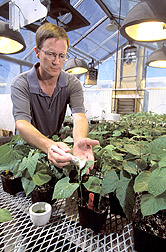This page has been archived and is being provided for reference purposes only. The page is no longer being updated, and therefore, links on the page may be invalid.
Bright New Dry Bean for Salads and Other Foods
By Jan SuszkiwJune 17, 2010
Crimson, a new cranberry dry bean cultivar, is now available for production in the form of foundation seed that could give rise to a new bumper crop of the colorful legume for 2010.
Crimson was developed by Agricultural Research Service (ARS) scientists from a cross between the commercial cultivar Cardinal and the dry bean breeding line PS98-302-5-5. According to ARS plant geneticist Phil Miklas, the combination of the two "parents" has endowed Crimson with viral disease resistance and a high yield of shapely, maroon-speckled seed.
Crimson's seed is also beautiful on the inside: It lacks a common but commercially unacceptable blemish called "black heart," adds Miklas, with the ARS Vegetable and Forage Crops Research Laboratory in Prosser, Wash.
Crimson owes its prized seed features and disease resistance to Cardinal, and specifically that cultivar's I and Bct genes, which confer protection against the bean common mosaic virus and beet curly top virus, respectively. Both are costly diseases of cranberry dry beans grown in Washington State, Oregon, California and Idaho for use as commercial seed to plant new crops and as food. The new cultivar also can tolerate the bean rust fungus, which is problematic in dry beans east of the Rocky Mountains.
Crimson's high yield comes from PS98-302-5-5, a breeding line which brings diversity from a tropic bean into the mix. In Washington State tests from 2004-06, it produced 350 pounds per acre more seed than its other parent, Cardinal. And during 2007-08 field tests at 11 sites across the country, Crimson produced on average 150 pounds more seed per acre than Capri, a top-performing commercial cultivar used for comparison. Crimson's plants also matured two days earlier than Capri.
ARS has applied for Plant Variety Protection on Crimson and is negotiating terms for an exclusive license to a private company to produce it commercially as certified seed.
ARS is the principal intramural scientific research agency of the U.S. Department of Agriculture.


